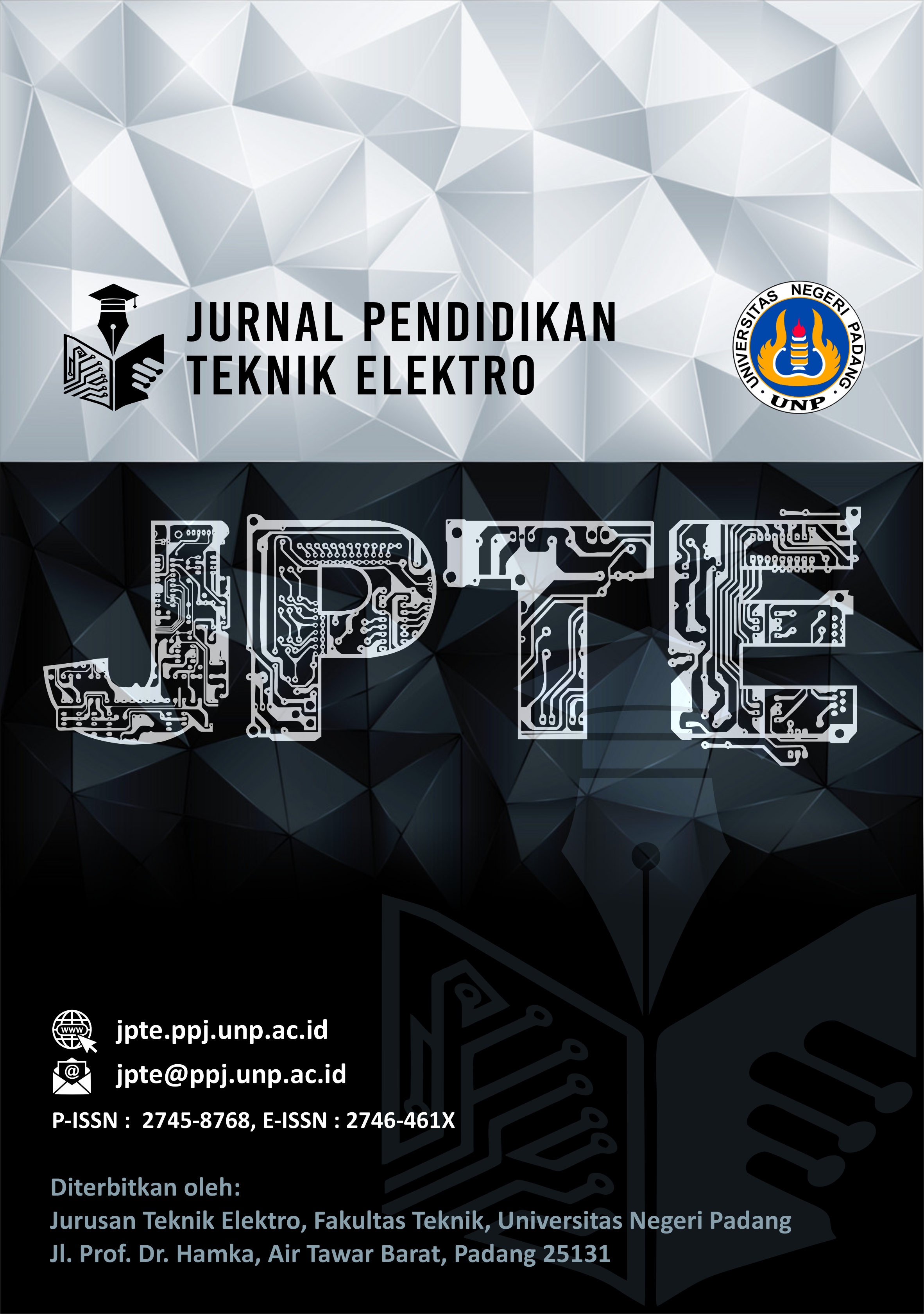Implementasi Metode Problem-Based Learning berbantuan Video Tutorial pada Mata Pelajaran Dasar Ketenagalistrikan
##plugins.themes.academic_pro.article.main##
Abstract
The low learning outcomes of students and the learning model applied to learning activities are less interesting for students to carry out learning activities, making students less able to understand the learning material presented. Therefore, it is necessary to take action to improve learning outcomes and student interest in learning activities. The purpose of this study was to determine the effectiveness of the Problem-Based Learning model assisted by video tutorials in improving learning outcomes in basic electricity subjects at SMKN 5 Solok Selatan. This study uses a quantitative research method using a quasi-experimental model with a one-group Pretest and Posttest design. The subjects in this study were students of class X TK B SMKN 5 Solok Selatan in the 2024/2025 academic year, with the number of students in class X TK B (15 students). Based on the results of the research that has been carried out, show that the Problem-Based Learning learning method significantly improves student learning outcomes. Based on the pretest data, many students have not achieved the KKTP score, with the majority of scores below standard. After implementing this method, the post-test results showed a significant increase with 80% of students successfully achieving or exceeding the completion standard. The effect size analysis shows that the impact of this method is large, indicating a substantial influence on improving student learning outcomes.
##plugins.themes.academic_pro.article.details##

This work is licensed under a Creative Commons Attribution 4.0 International License.
References
[2] R. Zuwe and Elfizon, “Pengembangan Media Pembelajaran Interaktif pada Mata Pelajaran Dasar Listrik dan Elektronika,” J. Pendidik. Tek. Elektro, vol. 2, no. 1, p. 70, 2021, doi: 10.24036/jpte.v2i1.86.
[3] V. A. Pratami and Elfizon, “Implementasi Kurikulum Merdeka pada Mata Pelajaran Dasar-Dasar Ketenagalistrikan di Sekolah Menengah Kejuruan,” J. Pendidik. Tek. Elektro, vol. 05, no. 02, p. 322, 2024, [Online]. Available: http://eprints.iainu-kebumen.ac.id/id/eprint/884/
[4] V. Puspitasari and A. Wahyuni, “Analisis penerapan project based learning (PJBL) pada pembelajaran ipas siswa kelas 4 dengan kurikulum merdeka,” Pendas J. Ilm. Pendidik. Dasar, vol. 08, no. 02, p. 2517, 2023.
[5] I. Yusika and T. Turdjai, “Penerapan Model Pembelajaran Berbasis Proyek (Pjbl) untuk Meningkatkan Kreativitas Siswa,” Diadik J. Ilm. Teknol. Pendidik., vol. 11, no. 1, p. 19, 2021, doi: 10.33369/diadik.v11i1.18365.
[6] M. Hardika and Elfizon, “Pengembangan E-Modul pada Proses Pembelajaran Instalasi Penerangan Listrik,” J. Pendidik. Tek. Elektro, vol. 2, no. 2, p. 117, 2021, doi: 10.24036/jpte.v2i2.128.
[7] D. T. P. Yanto, M. Kabatiah, H. Zaswita, G. Giatman, and H. Effendi, “Development of Virtual Learning using Problem-Based Learning Models for Vocational Education Students,” ELINVO (Electronics, Informatics, and Vocational Education), vol. 7, no. 2, pp. 163–172, 2022, doi: 10.21831/elinvo.v7i2.52473.
[8] A. Putra and Elfizon, “Pengembangan Modul Berbasis Masalah pada Mata Pelajaran Dasar Listrik dan Elektronika,” J. Pendidik. Tek. Elektro, vol. 01, no. 01, p. 48, 2020.
[9] I. Anas and S. Zakir, “Artificial Intelligence: Solusi Pembelajaran Era Digital 5.0,” J. Sains Komput. Inform., vol. 8, no. 1, p. 35, 2024.
[10] P. S. Dewi, “E-Learning : Penerapan Project Based Learning pada Mata Kuliah Media Pembelajaran,” Prisma, vol. 10, no. 1, p. 97, 2021, doi: 10.35194/jp.v10i1.1012.
[11] F. T. S. Utomo, “Inovasi Media Pembelajaran Interaktif untuk Meningkatkan Efektivitas Pembelajaran Era Digital d Sekolah Dasar,” J. Ilm. Pendidik. Dasar, vol. 08, no. 02, p. 3635, 2023.
[12] R. Fitrianingsih and Musdalifah, “Efektivitas Penggunaan Media Video Pada Pembelajaran Pembuatan Strapless Siswa Kelas XII SMK Negeri 1 Jambu,” Fash. Fash. Educ. J., vol. 4, no. 1, pp. 1–6, 2015.
[13] A. Suci and M. Riki, “Efektivitas model pembelajaran Problem-Based Learning pada mata pelajaran dasar listrik dan elektronika,” J. Multidicsiplinary Res. Dev., vol. 2, no. 2, pp. 51–57, 2020.
[14] D. T. P. Yanto et al., “Innovative Laboratory Learning: A Study Evaluating the Practicality of Integrated E-Worksheets with Augmented Reality in Electrical Machines Course,” International Journal of Information and Education Technology, vol. 14, no. 7, pp. 996–1005, 2024, doi: 10.18178/ijiet.2024.14.7.2127.
[15] A. Farisi, A. Hamid, and Melvina, “Pengaruh Model Pembelajaran Problem-Based Learning TerhadapKemampuan Berpikir Kritis Dalam Meningkatkan Hasil BelajarSiswa Pada Konsep Suhu Dan Kalor,” J. Ilm. Mhs. Pendidik. Fis., vol. 2, no. 3, pp. 283–287, 2017.
[16] A. Luk, “Teaching intellectual property law today: testing the relevance of the ‘problem-based learning’ method,” Law Teach., vol. 00, no. 00, pp. 1–16, 2024, doi: 10.1080/03069400.2024.2422255.
[17] C. E. Parasamya and A. Wahyuni, “Upaya Peningkatan Hasil Belajar Fisika Siswa melalui Penerapan Model Pembelajaran Problem-Based Learning (PBL),” J. Ilm. Mhs. Pendidik. Fis., vol. 2, no. 1, pp. 42–49, 2017.
[18] W. Awamleh, “The effectiveness of e-project-based learning in improving the academic achievement and motivation of special education female students,” Cogent Educ., vol. 11, no. 1, p., 2024, doi: 10.1080/2331186X.2024.2369968.
[19] H. Fauziah, “Penerapan Model Pembelajaran Problem-Based Learning untuk Meningkatkan Hasil Berlajar Matematika SD,” J. Prim., vol. 7, no. 1, p. 42, 2018, doi: 10.55215/pedagogia.v14i2.6611.
[20] H. Ahmar, P. Budi, M. Ahmad, A. Mushawwir, and Z. Khaidir, “Penerapan Model Pembelajaran Problem-Based Learning : Literature Review,” J. Keperawatan Muhammadiyah, p. 14, 2020, [Online]. Available: http://journal.um-surabaya.ac.id/index.php/JKM
[21] T. Djonomiarjo, “Pengaruh Model Problem-Based Learning Terhadap Hasil Belajar,” J. Ilmu Pendidik. Nonform. Aksara, vol. 05, pp. 39–40, 2019, [Online]. Available: http://ejurnal.pps.ung.ac.id/index.php/AKSARA/index
[22] N. M. I. Priyanti and Nurhayati, “Penerapan Model Pembelajaran Problem-Based Learning Berbantuan Media Youtube Untuk Meningkatkan Hasil Belajar,” J. Ilm. Mat. Realis., vol. 4, no. 1, p. 97, 2023.
[23] D. Setiawan and I. G. P. A. Buditjahjanto, “Pengaruh Metode Pembelajaran Inkuiri Terhadap Ketuntasan Hasil Belajar Siswa Di Smkn 3 Buduran Sidoarjo,” J. Pendidik. Tek. Elektro, vol. 2, no. 1, p. 302, 2013.
[24] T. Martias and H. Effendi, “Efektivitas E-Modul pada Mata Pelajaran Dasar-Dasar Ketenagalistrikan Kelas X di Sekolah Menengah Kejuruan,” J. Pendidik. Tek. Elektro, vol. 04, no. 02, p. 409, 2023, [Online]. Available: http://jpte.ppj.unp.ac.id/index.php/JPTE/article/view/352

